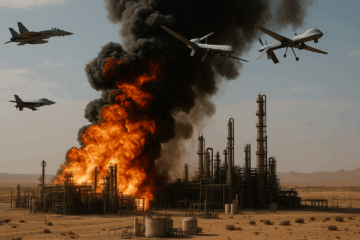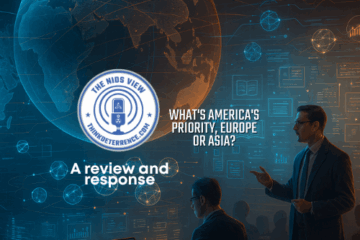In a recent Foreign Affairs article, Former Secretary of Defense Robert Gates writes,
The United States now confronts graver threats to its security than it has in decades, perhaps ever. Never has it faced four allied antagonists at the same time—Russia, China, North Korea, and Iran—whose collective nuclear arsenal could within a few years be nearly double the size of its own. Not since the Korean War has the United States had to contend with powerful military rivals in both Europe and Asia. And no one alive can remember a time when an adversary had as much economic, scientific, technological, and military power as China does today.
These ominous developments did not happen overnight but are made worse by bad American security policy decisions just as China and Russia were simultaneously deciding to confront the United States leadership role in the world. Critical to a growing China and Russia threat is bad American nuclear policy choices.
Key to this decline were ten bad American policy decisions. These policies began in the wake of the Soviet Union’s decline and continue to the present. Let me explain.
First, America began by buying Francis Fukuyama’s flawed “end of history” thesis and believed that the “liberal international order” of the early post–Cold War period would remain in perpetuity, with authoritarian regimes collapsing as democracy and capitalism triumphed. This, as we know, proved untrue.
Second, the United States unilaterally eliminated almost its entire theater nuclear weapons arsenal, the very type of nuclear forces where there is now a serious and growing imbalance between the United States and China and Russia.
Third, after terrorism took the place of the Soviet Union as America’s top threat, the United States identified the solution to terrorism as democratization through force. The attacks on the World Trade Center (1993), Khobar Towers (1996), US embassies in Africa (1998), and USS Cole (DDG-67) were the kindling that served, in part, to justify the later invasions of Iraq and Afghanistan.
Fourth, despite the extraordinary take down of Saddam’s Iraqi forces in Gulf War I (1991), the deterrent value of liberating Kuwait disappeared by the time of the September 11, 2001, attacks, which were then followed by two more decades of futile efforts in nation building in Iraq and Afghanistan.
Fifth, the United States long assumed a cooperative arrangement with China and Russia would prevent nuclear proliferation. American leaders failed to recognize that both nations played an important role in enabling North Korea’s successful nuclear program. The proliferation of nuclear weapons began with a 1982 decision by Deng Xiaoping and Yuri Andropov to transfer nuclear technology to client states.
Sixth, for three decades following the Soviet Union’s collapse, the US took a holiday from modernizing the nuclear deterrent. Now, as the US attempts to reverse course, the entire nuclear establishment requires refurbishment to make modernization possible.
Seventh, the US ignored Russian incursions into Georgia, Moldova, and Ukraine during 2008–2014. Then, just prior to the 2022 invasion, the US compounded these mistakes by both declaring that the US response would depend upon how much Ukraine territory was taken or, later during the war, Ukraine could negotiate an end to the war by ceding additional territory to Russia—a country responsible for the deaths of many millions of Ukrainians during the Soviet Union’s existence. This only encourages Russian aggression.
Eighth, the US abandoned Afghanistan and left significant military equipment behind for the Taliban to use. A billion-dollar embassy and $14 billion worth of military equipment was quickly incorporated into the new Taliban-led government’s arsenal or sold to terrorist organizations around the world. The American withdrawal from Afghanistan was a humiliating action that undermined respect for the United States.
Ninth, the Obama administration’s Joint Comprehensive Plan of Action (JCPOA) with the Iranian regime allowed Tehran to continue its ballistic missile and nuclear program with increased funding from a return of assets previously seized by the United States. The Trump administration brought Iran under some semblance of control by cutting its foreign exchange reserves by over $100 billion. The killing of the Iranian Revolutionary Guard Corps’ General Qasem Soleimani was a clear signal that then-President Donald Trump would not tolerate Iranian-backed terrorism.
The Biden administration backtracked on efforts to deter Iran. Since October 2023, Iran has conducted 170 attacks, primarily against US and assets in the region. Iran combined forces with Houthi rebels to largely shut down commercial freight and crude oil shipments through the Straits of Hormuz. Iran also rebuilt its foreign exchange reserves, while becoming more closely allied with Russia and China. This all took place as Iran moved closer to a nuclear weapon.
Tenth, the United States long dismissed warnings about the rise of Chinese military power and the threat it posed to the United States. President Xi Jinping’s massive investment in cyber, space, conventional, and nuclear weaponry will soon make China a peer of the United States. Asian allies of the United States are increasingly worried by China’s actions.
The United States must act to alter its course before it is too late. A return to a strong military, capable of fighting two peer competitors is necessary. It may also be time for a second Manhattan Project to implement the Congressional Strategic Posture Commission’s recommendations. With nuclear modernization facing regular delays, there may be no other option. Whatever the solutions are, the time to act is now.
Peter Huessy is a Senior Fellow at the National Institute for Deterrence Studies, CEO of Geostrategic Analysis, and host of a forty-plus year series of seminars and symposiums on nuclear matters. The views expressed in this article are the author’s own.
About the Author

Peter Huessy
Mr. Peter Huessy is President of his own defense consulting firm, Geostrategic Analysis, founded in 1981, and through 2021, Director of Strategic Deterrent Studies at the Mitchell Institute on Aerospace Studies. He was the senior defense consultant at the National Defense University Foundation for 22 years. He was the National Security Fellow at the AFPC, and Senior Defense Consultant at the Air Force Association from 2011-2016.
Mr. Huessy has served as an expert defense and national security analyst for over 50 years, helping his clients cover congressional activities, arms control group efforts, nuclear armed states actions, and US administration nuclear related policy, budgets, and strategies, while monitoring budget and policy developments on nuclear deterrence, ICBM modernization, nuclear arms control, and overall nuclear modernization.
He has also covered nuclear terrorism, counterterrorism, immigration, state-sponsored terrorism, missile defense, weapons of mass destruction, especially US-Israeli joint defense efforts, nuclear deterrence, arms control, proliferation, as well as tactical and strategic air, airlift, space and nuclear matters and such state and non-state actors as North Korea, China, Iran, Syria, Venezuela and Hezbollah, Hamas, and Al Qaeda. This also includes monitoring activities of think tanks, non-governmental organizations, and other US government departments, as well as projecting future actions of Congress in this area. His specialty is developing and implementing public policy campaigns to secure support for important national security objectives. And analyzing nuclear related technology and its impact on public policy, a study of which he prepared for the Aerospace Corporation in 2019.




